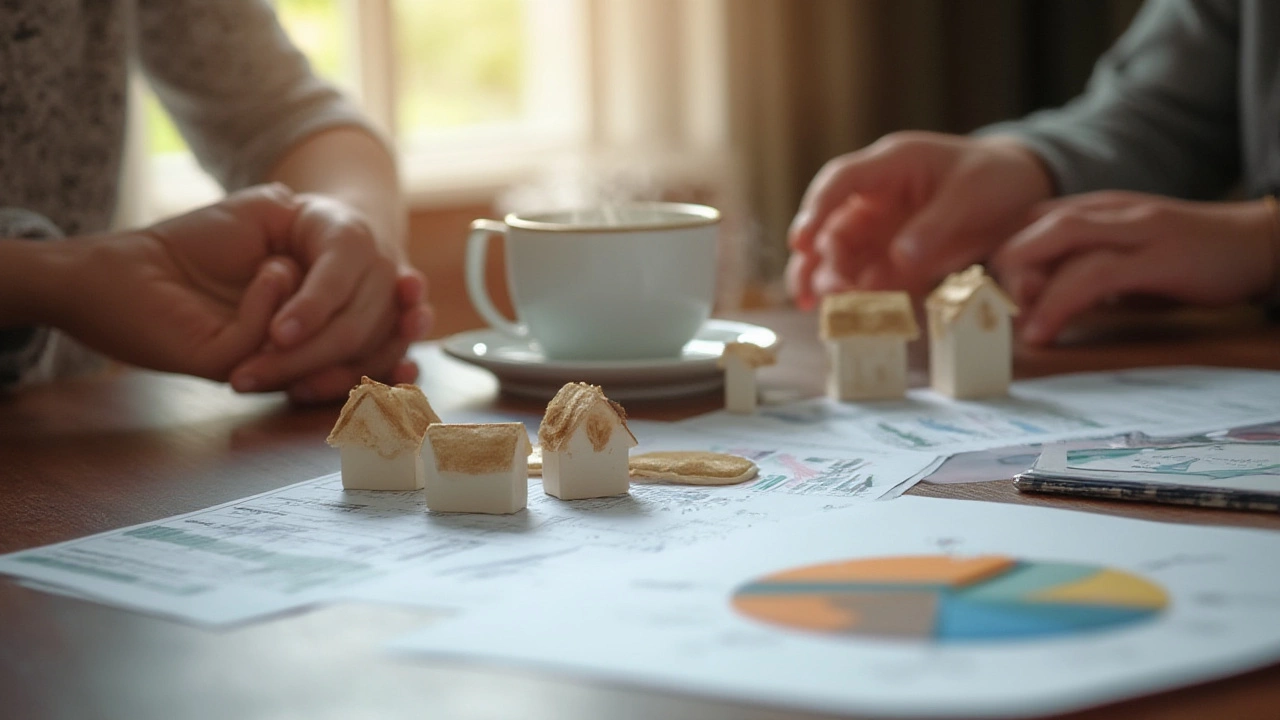Imagine driving past a block of new flats with big "Shared Ownership" banners plastered across them. Or maybe you’ve heard a friend say they “own half” of their place. It sounds a bit like splitting fries—except, you know, each fry is worth thousands of pounds. The idea of property ownership being split into shares trips up even the most clued-up buyers. But here’s the wild part: shared ownership isn’t just about helping first-time buyers. It’s shaping whole new ways people buy, invest, and think about their homes. Let's bust some myths, lay out the hard truths, and actually make sense of shared ownership—without the sales talk or lawyer-speak people keep throwing around.
What Are Ownership Shares—And Who Actually Uses Them?
Ownership shares aren’t some new, fancy trick invented last year. In fact, England’s shared ownership model has been kicking around in various forms since the 1970s. Think of it as picking the size pizza you can afford now, while knowing you can grab a bigger slice later if your wallet (or luck) improves. With property prices up 54% in a decade (according to the UK Office for National Statistics), more buyers now lean on shared ownership just to step onto that elusive first rung of the ladder—but it’s not only for newcomers.
Let’s break down who’s grabbing at the pie:
- First-time buyers who just can’t save a huge deposit or get approved for a massive mortgage.
- Key workers—think NHS nurses, teachers—sometimes get first dibs or priority.
- Downsizers looking for less responsibility, but still wanting to keep a foot on property’s gravy train.
- Savvy investors who spot new schemes or demand for special needs housing that uses fractional ownership models.
So, what’s actually happening? You (the buyer) purchase a percentage of the home—say, 25% up to 75%—with a housing association keeping the rest. Simple enough? Kind of. You pay a mortgage on your share and a below-market rent on the rest. The dream: "staircasing" your way up, buying more of the property over time. But, just like those pizza slices, the more you want, the more you pay—and the toppings aren’t free. Here's the kicker: anyone can apply, but different schemes—from Help to Buy to bespoke local council arrangements—come with their quirks.
Sceptical? The numbers might surprise you. In 2023, over 14,000 new shared ownership homes were delivered in England alone. Not all stories are dream come true. Some people find staircasing too pricey, or dislike dealing with two parties (lender and association) at once. But for many, it’s either this or permanent renting. So who actually makes the rules? Housing associations set most of them, but the government provides official guidance, last updated in October 2023.
How the Mechanics of Shared Ownership Shares Actually Work
Let’s kill the confusion: shared ownership isn’t the same as timeshares, and you don’t live with a stranger. You get your own flat or house; you just own less of it than you would under a traditional mortgage. Here’s the breakdown using a real-world example:
- You buy a 40% share of a £300,000 home. So, your purchase price is £120,000. Usually, you’ll need a deposit for your part—say, 5%—so in this case, £6,000 plus other buying fees.
- The housing association owns the remaining 60% and charges you rent on it, often much lower than the open market. In typical schemes, this runs at 2.75% of the unowned share’s value per year.
- You pay both a mortgage (on your share) and the rent (on the part you don’t own). It feels like a double whammy, but your total monthly outgoings are usually less than renting the same property outright.
It looks good on paper, but the plot thickens: you’re responsible for 100% of the maintenance and repairs, even if you only own 25%. And—awkward alert—if you want to sell, the housing association has "first refusal." They can find a new shared owner before you can try the open market. That can impact resale times and prices.
Now, here’s where it gets tricky: "staircasing.” Say, after five years, you’ve saved enough to buy an extra 20%. Your new share is now 60%. Each time you buy more, the price is based on the property’s current (often higher) valuation. Plus, there are legal and surveyor fees each time you staircase—costs buyers often overlook when dreaming up their five-year plans.
| Scenario | Monthly Cost Estimate (£) | Deposit Required (£) |
|---|---|---|
| 100% Outright Purchase (£300,000) | £1,400 (mortgage only) | £15,000 (5%) |
| 50% Shared Ownership | £800 (mortgage + rent) | £7,500 (5%) |
| 25% Shared Ownership | £600 (mortgage + rent) | £3,750 (5%) |
Here’s a practical tip: always get a full breakdown from your housing association of ALL costs (including future staircasing). Many buyers get caught off guard with unexpected legal or survey fees later on.
One myth still spreads like wildfire: you can always staircase to 100%. Actually, some schemes cap the percentage you can own—especially in rural or specialist housing. Always check your scheme’s contract, or you might hit an ownership ceiling you didn’t see coming.

Legal, Tax, and Practical Surprises You Didn’t Expect
When you buy a normal house, you get one chunky paper called "title deeds." With shared ownership, things get a bit more tangled. Legally, most buyers are leaseholders, not full freeholders. The housing association keeps hold of the freehold, so your agreement spells out what you can (and, let's be honest, can’t) do—a bit like strict parents at a sleepover.
Key legal quirks most people miss:
- You’ll have a lease, usually 99 or 125 years. If the lease term runs low, selling can get tricky as mortgage lenders don’t like short leases. Always check the remaining term before you sign.
- Service charges can be unpredictable. Just because you only own part of the building doesn’t mean you’re off the hook. You’ll still pay full whack to maintain shared parts—lifts, gardens, roofs.
- Stamp duty: for first-time buyers, there’s often a way to pay stamp duty just on your share initially. But if you staircase to over 80%, you might have to pay stamp duty on the full value—sometimes years later.
One brutal fact: repairs and maintenance are your problem from day one. In 2024, the government tried to ease this by giving new-but-not-secondhand shared owners a "10-year repair-free period"—but only for properties built and bought after April 2021. This mostly covers certain systems, but not big-picture issues or older shared homes.
If you ever fancy moving, brace yourself. The association usually gets between 4–8 weeks to try and find a new buyer (at a price based on yet another valuation). If they can’t, you’re free to list elsewhere, but the clock can tick painfully slow.
"Shared ownership was never meant to be a forever solution for buyers or the housing system. It’s a stepping stone. But for many, it’s become a long-term home because the path to full ownership can be financially steep," says Paul Hackett, CEO of Optivo, a leading housing association, in a BBC Radio 4 interview, 2023.
If you hit money trouble, there are support options—Government schemes, hardship policies from associations—but repossession can still happen. Missed payments on rent or service charges can result in losing your stake much faster than a regular mortgage default. Don't treat it like a soft option; the rules bite hard if you slip up.
Tips for Making Shared Ownership Work for You
You want practical, not just promises. Here’s what I wish more buyers (and investors) knew:
- ownership shares schemes are not all equal. Compare at least three: some will allow you to staircase in small (5% or 10%) increments, others force bigger chunks. See what fits your savings pattern.
- Always factor in yearly rent increases. Most are linked to inflation (RPI + a %), and in 2024, lots of buyers faced 7%+ annual jumps. Even if your mortgage is fixed, rent might go up anyway.
- Ask to see the building’s 5-year maintenance plan. Nasty service charge surprises can blow your budget—even if your own share is small.
- Talk to existing residents. Some housing associations manage better than others—ask about repairs, service, communication. The "hidden cost" of hassle is real.
- If staircasing is your endgame, plan out when you’ll realistically be able to afford the next step—based on projected salary and property price growth, not just wishful thinking.
- Resale values for shared ownership homes can be unpredictable. Check real sales, not just estate agent listings. The local council’s housing statistics portal or Rightmove’s Sold Prices can help you here.
- Check for local caps: in some rural areas or new towns, there are hard limits on how much of a property you can own, no matter how much cash you have.
- Keep a record of all upgrades and permissions. Some associations want written approval for everything from new windows to painting the door red—skipping this can block a resale or staircasing later.
Before signing anything, use the government’s Shared Ownership Calculator (updated in April 2025). It’ll show a breakdown of deposits, mortgage payments, rent, fees, and likely costs for each staircasing jump. Run your scenario through it—and do two or three "what if" options, in case interest rates change or your salary fluctuates.
Thinking about investing? Buyer demand for shared ownership is forecast to rise another 15% by 2026 as traditional affordability barriers continue and remote work means more people settle for smaller shares near cities. Some investor groups buy multiple small shares (in different new-builds), then sell them on piecemeal, though rules and taxation here can be pretty gnarly. Always take local legal advice before assuming that path fits your risk tolerance.
And finally, remember: shared ownership is all about compromise. Lower outgoings, but less control. A foot on the ladder, but lots of rules you don’t get to set. For the right person? It’s a launchpad. For others, it’s a maze. If you get your numbers right and stay sharp about changing your share, it can still be the smartest move in 2025’s wild property market.
